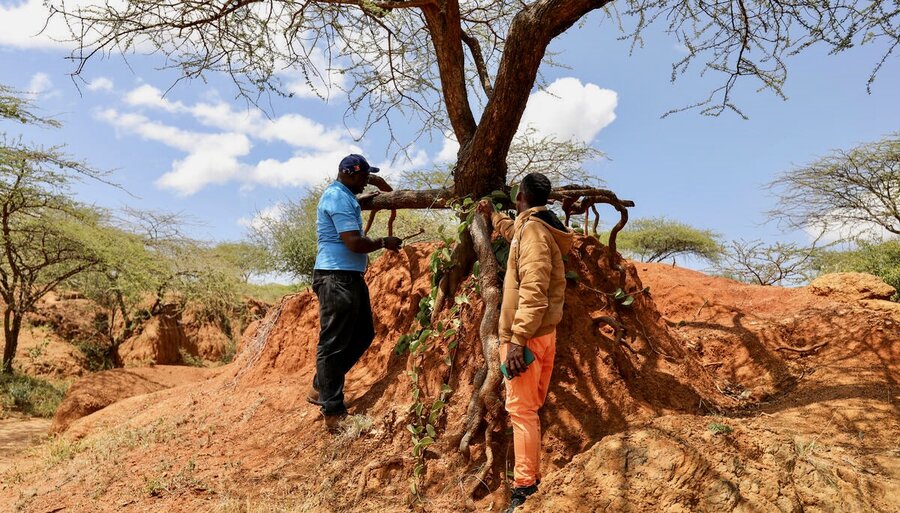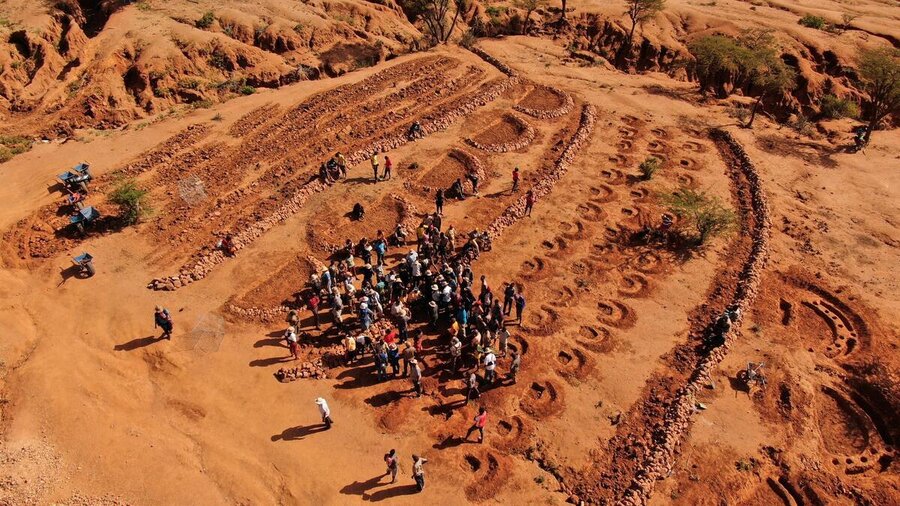In Kenya, young and old are joining forces to heal the land

Standing on the edge of a metre-deep trench dug into the red earth, John Lekupes and John Lerosion point to the acacia tree on the other side.
“The heavy rain has eroded the soil around the tree’s roots,” Lekupes says of the 50-centimetre gap between the top roots and the ground. “Soon, that tree will die.”
Both in their twenties, Lekupes and Lerosion share more than a first name. Selected as local leaders by their pastoralist community in Kenya’s central Isiolo County, they have been trained in environmental conservation techniques by engineers from the World Food Programme (WFP) and the local government. Today, they and 15 other ‘master trainers’ in the area are passing on that knowledge to others in their communities, in a bid to restore the local ecosystem - and livelihoods.
“Ecosystem restoration strengthens soil health, improves water management, increases biodiversity for pollinators, and provides sustainable resources that support nature-based enterprises,” says Charles Songok, who heads WFP’s Isiolo office. “Without proper care for the ecosystem, no community can feed itself, generate economic activities and sustain its livelihoods.”

Such efforts are key for Kenyan pastoralists and others to build resilience to extreme weather events, which are becoming ever more frequent and devastating. The stakes are especially high for villages like Raap, where Lekupes and Lerosion live. It is located in one of the most degraded areas of Isiolo County. Two-thirds of the land is classified as arid, due to harmful practices like deforestation, overgrazing and charcoal production.
Africa’s hunger driver
Isiolo’s challenges reflect a continental trend. A recent study finds 65 percent of Africa’s land is degraded, posing a serious threat to food security.
In Raap, elders describe the land as once lush and fertile. But in recent years, a cycle of floods and drought - including, most recently, Kenya’s worst dry spell in decades - has taken its toll, killing livestock and depleting the land. Now, old and young generations have joined forces to restore the ecosystem so it can sustain their livelihoods.
“Our elders say that we, the youth, have loaned them this land, and they owe a debt to us,” says Lekupes. “The old people are very important for land restoration, because they know how this land was before. They motivate us to regain it.”

He and his counterpart Lerosion are leading a village effort to build terraces to catch rainwater and to reduce erosion - thanks to training, tools and mechanical support provided by WFP.
Already, it is delivering results. “Before this project, the community was pessimistic,” Lekupes recalls. But, he adds, “just three weeks ago, when we had heavy rain, the terraces we built held a lot of water.”
To prevent gulleys from deepening, the villagers are tapping conservation technologies such as placing branches, twigs and other plant materials across or inside the gullies to slow down water flow, trap sediment and promote vegetation regrowth. Eventually, the gulleys will fill with soil again and regenerate the land, allowing grass to grow.
Until that happens, the two young men have created makeshift bridges with burlap bags filled with soil, so children can cross the gulleys safely when they walk to school — and villagers can easily access the local market.

“This project has helped this community so much. Now we have become one, and everyone is very willing to work to regain this land,” says Lekupes.
He dreams of the day when his work will pay off in other ways.
“In twenty years, I would like to see the land being regained, no more gulleys - and children walking along where these gulleys were,” says Lekupes, his gaze sweeping over the valley. “When a gulley dies, it means the land is healing.”
WFP continues to spearhead the community’s effort to restore the degraded land and open it up for livestock and crop production,improving their food and nutrition security, diversifying their livelihoods and incomes with support from the Bavarian State Government, the Korean International Development Agency (KOICA), and the Zoetis Foundation.
